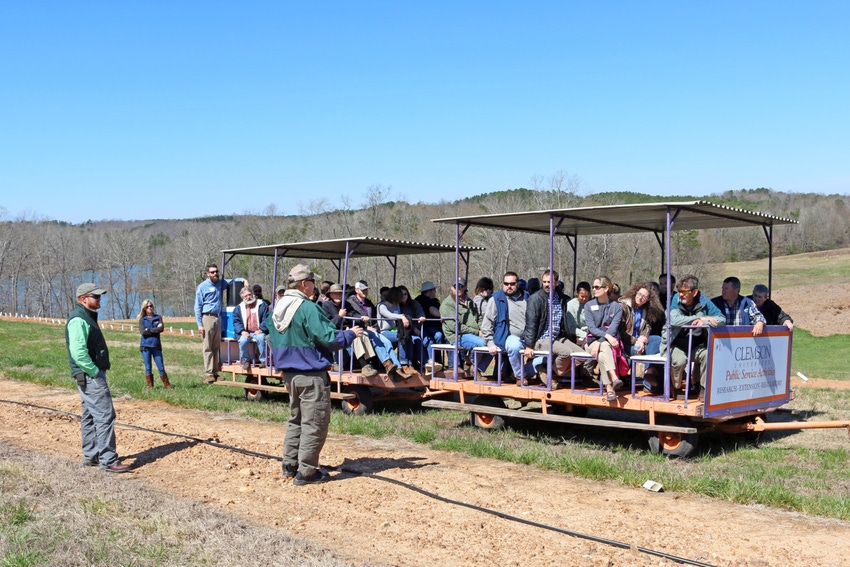April 9, 2019

Clemson and Auburn universities often have been foes on the fields of play, but when it comes to the land-grant mission, the two schools are practically on the same team.
The horticulture program teams from Clemson Cooperative Extension Service and the Alabama Cooperative Extension System (ACES) at Auburn University came together recently to open up their respective playbooks for a two-day joint team meeting on Clemson’s campus.
Clemson Extension Horticulture Program team leader Cory Tanner said collaboration between land-grant institutions and Extension services is critical to their mission and success as they aim to improve the quality of life for residents of their states by providing unbiased, research-based information through an array of public outreach programs.
“It’s in our very name, ‘Cooperative Extension,’ to share and collaborate, and it’s only natural to do so in the southeastern states because of similarities in growing conditions — climate and soil — and crops,” Tanner said. “With Alabama specifically, there are many similarities with South Carolina, including agricultural practices, but also demographically and how our Extension systems are structured. We learned a lot from the Alabama team about how they structure and evaluate their programs, and a number of those strategies will benefit us here at Clemson Extension.”
The teams convened at Clemson’s Lehotsky Hall on March 20 for presentations from Clemson faculty and scientists: plant and environmental sciences Chair Carlyle Brewster on Extension interaction, assistant professor Dave Coyle on social media as an Extension communication tool, associate professor Cal Sawyer on water issues and Extension response in South Carolina and professor Guido Schnabel on integrated pest management.
“It was a great opportunity to work with people who have different backgrounds but are still working towards the same goal,” said Auburn assistant professor and Extension specialist Katelyn Kesheimer. “Auburn and Clemson Extension both aim to educate and help their local communities, so the trip was an awesome learning experience on new, creative ways to go about that. I came home with new perspectives and inspiration to apply to my own Extension program.”
After the morning classroom sessions, the teams toured Clemson’s Musser Fruit Research Center, a 240-acre fruit tree research farm dedicated to developing and disseminating knowledge for sustainable production in the Southeast. While there, members of Clemson’s Peach Team, including Greg Reighard, Schnabel, Ksenija Gasic, Douglas Bielenberg and Juan Carlos Melgar, shared information about the research there.
ACES regional Extension agent Kevin Burkett said working with and learning from other universities and Extension programs is useful because it offers a chance to expand individual viewpoints and draw comparisons and differences between similar colleagues.
“If we limited ourselves to county or state lines there would be little collaboration and transfer of knowledge — and that goes against the mission of Extension,” Burkett said. “We pride ourselves on being leaders of knowledge, technology and best practices, so in the same way we have to go out and continue to expand what we know. Being in the same region, the southeastern U.S., there are quite a few parallels between Clemson and Auburn. It was a great opportunity to get together and we look forward to continuing to develop those connections and relationships.”
The second day of the joint meeting included a presentation from Clemson communications specialist Dawn White on Land-Grant Press by Clemson Extension, a first-of-its-kind online platform for science-based, peer-reviewed publications written by Extension personnel and university scientists for professional stakeholder audiences. Clemson will launch Land-Grant Press later this year.
Other speakers included South Carolina food crop agents on horticulture crop production in the state, ACES Commercial Horticulture Program team leader Ayanava Majumdar and Clemson Horticulture Extension agent Zack Snipes on Beginning Farmer Programs and Majumdar on digital communication and marketing systems.
Majumdar said the primary areas of future collaboration that he identified are grant development/joint-implementation; core horticulture programs including fruits, turfgrass, organic vegetable production and school programs; developing new regional Extension publications and assisting in the peer-review process; and Extension program evaluation and reporting.
“We are super excited to know about the Clemson Extension team and the great work they are doing helping farmers, youth and gardeners, among other clientele,” Majumdar said.
After the classroom portion of the second meeting day, the teams took a tour of Clemson’s athletic facilities, including Memorial Stadium, the football practice facilities and Doug Kingsmore Stadium, led by supervisor of athletic grounds Mike Echols and professor of turfgrass science and management Bert McCarty.
The meeting concluded with a tour of Clemson’s Student Organic Farm and a small tools demo led by Clemson professor Geoff Zehnder, farm manager David Robb and Snipes.
“I feel that the joint horticulture team meeting between Clemson and Auburn universities embodies the land-grant mission to take the university to the people,” Snipes said. “When we have the opportunity to learn from colleagues, we can share experiences that will make us all more efficient and impactful in our day-to-day work. Getting to hear about programs and how Auburn agents have impacted their clientele was a source of inspiration. It feels good knowing that there are agents all over that want to get in to their communities, roll up their sleeves and make a difference; in one way or another we are all cut from the same cloth.”
Source: Clemson University, which is solely responsible for the information provided and is wholly owned by the source. Informa Business Media and all its subsidiaries are not responsible for any of the content contained in this information asset.
About the Author(s)
You May Also Like




